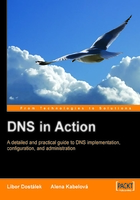
1.1 Domains and Subdomains
The entire Internet is divided into domains, i.e., name groups that logically belong together. The domains specify whether the names belong to a particular company, country, and so forth. It is possible to create subgroups within a domain that are called subdomains. For example, it is possible to create department subdomains for a company domain. The domain name reflects a host’s membership in a group and subgroup. Each group has a name affiliated with it. The domain name of a host is composed from the individual group names. For example, the host named bob.company.com consists of a host named bob inside a subdomain called company, which is a subdomain of the domain com.
The domain name consists of strings separated by dots. The name is processed from left to right. The highest competent authority is the root domain expressed by a dot (.) on the very right (this dot is often left out). Top Level Domains (TLD) are defined in the root domain. We have two kind of TLD, Generic Top Level Domain (gTLD) and Country Code Top Level Domain (ccTLD). Well known gTLDs are edu, com, net, and mil which are used mostly in the USA. According to ISO 3166, we also have two letter ccTLD for individual countries. For example, the us domain is affiliated with USA. However ccTLD are used mostly outside the USA. A detailed list of affiliated ccTLD and their details are listed in Appendix A.
The TLD domains are divided into subdomains for particular organizations, for example, coca-cola.com, mcdonalds.com, google.com. Generally, a company subdomain can be divided into lower levels of subdomains, for example, the company Company Ltd. can have its subdomain as company.com and lower levels like bill.company.com for its billing department, sec.company.com for its security department, and head.company.com for its headquarters.
The names create a tree structure as shown in the figure:

Figure 1.1a: The names in the DNS system create a tree structure
The following list contains some other registered gTLDs:
- The
.orgdomain is intended to serve the noncommercial community. - The
.aerodomain is reserved for members of the air transport industry. - The
.bizdomain is reserved for businesses. - The
.coopdomain is reserved for cooperative associations. - The
.intdomain is only used for registering organizations established by international treaties between governments. - The
.museumdomain is reserved for museums. - The
.namedomain is reserved for individuals. - The
.prodomain is being established; it will be restricted to credited professionals and related entities.